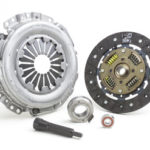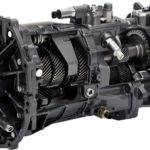A torque converter is a type of fluid coupling which is used to transfer rotating power from the engine of a vehicle to the transmission. It takes place of a mechanical clutch in an automatic transmission. Its main function is to allow the load to be isolated from the main power source. It sits in between the engine and transmission. It has the same function as the clutch in manual transmission. As the clutch separates the engine from the load when it stops, in the same way, it also isolates the engine from the load and keeps the engine running when the vehicle stops. Its main functions are:
1. It transfers the power from the engine to the transmission input shaft.
2. It drives the front pump of the transmission.
3. It isolates the engine from the load when the vehicle is stationary.
4. It multiplies the torque of the engine and transmits it to the transmission. It almost doubles the output torque.
Working Principle

To understand the working principle of a torque converter, let’s take two fans. One fan is connected to the power source and the other is not connected to the power source. When the first fan connected to the power source starts moving, the air from it flows to the second fan which is stationary. The air from the first fan strikes on the blades of the second fan and it also starts rotating almost at the same speed as the first one. When the second fan is stopped, it does not stop the first one. The first fan keeps rotating.
On the same principle, the torque converter works. In that, the impeller or pump acts as the first fan which is connected to the engine, and the turbine acts as the second fan which is connected to the transmission system. When the engine runs, it rotates the impeller and due to the centrifugal force, the oil inside the torque converter assembly is directed towards the turbine. As it hits the turbine blades, the turbine starts rotating. This makes the transmission system rotate and the wheels of the vehicle move. When the engine stops, the turbine also stops rotating but the impeller connected to the engine keeps moving and this prevents the killing of the engine.
Also Read:
- Manual Vs Automatic Transmission
- What are Different Types of Engine – Complete Explanation
- How Automatic Transmission Works? – Best Explanation Ever
Main Parts of Torque Converter
The torque converter has three main parts
1. Impeller or Pump
The impeller is connected to the housing and the housing is connected to the engine shaft. It has curved and angled vanes. It rotates with the engine speed and consists of automatic transmission fluid. When it rotates with the engine, the centrifugal force makes the fluid move outward. The blades of the impeller are designed in such a way that it directs the fluid towards the turbine blades. It acts as a centrifugal pump which sucks the fluid from the automatic transmission and delivers it to the turbine.
2. Stator
The stator is located in between the impeller and turbine. The main function of the stator is to give direction to the returning fluid from the turbine so that the fluid enters the impeller in the direction of its rotation. As the fluid enters in the direction of the impeller, it multiplies the torque. So stator helps in the torque multiplication by changing the direction of the fluid and allowing it to enter in the direction of the impeller rotation. The stator changes the direction of fluid almost up to 90 degrees. The stator is mounted with a one-way clutch that allows rotation in one direction and prevents its rotation in another direction. The turbine is connected to the transmission system of the vehicle. The stator is placed in between the impeller and turbine.
3. Turbine
The Turbine is connected to the input shaft of the automatic transmission. It is present on the engine side. It also consists of curved and angled blades. The blades of the turbine are designed in such a way that it can change the direction of the fluid completely that strikes its blades. It is the change in the direction of the fluid that forces the blades to move in the direction of the impeller. As the turbine rotates the input shaft, the transmission also rotates and makes the vehicle move. The turbine also has a lock-up clutch at its back. The lock-up clutch comes into play when the torque converter achieves a coupling point. the lockup eliminates the losses and improves the efficiency of the converter.
Working of Torque Converter
It has three stages of operations
1. Stall:
During the stall (stop) condition of the vehicle, the engine applies power to the impeller but the turbine cannot rotate. This happens when the vehicle is stationary and the driver has kept his foot on the brake paddle to prevent it from moving. During this condition maximum multiplication of torque takes place. As the driver removes its foot from the brake paddle and presses the accelerator paddle, the impeller starts moving faster and this sets the turbine to move. In this situation, there is a larger difference between the pump and turbine speed. The impeller speed is much greater than the turbine speed.
2. Acceleration:
During acceleration, the turbine speed keeps on increasing, but still, there is a large difference between the impeller and turbine speed. As the speed of the turbine increases the torque multiplication reduces. During acceleration of the vehicle, the torque multiplication is less than that achieved during stall conditions.
3. Coupling:
It is a situation when the turbine achieves approximately 90 percent speed of the impeller and this point is called the coupling point. The torque multiplication seizes and becomes zero and the torque converter behaves just like a simple fluid coupling. At the coupling point, the lock-up clutch comes into play and locks the turbine to the impeller of the converter. This causes the turbine and impeller to move at the same speed. Lock up clutch engages only when the coupling point is achieved. During coupling point the stator also starts to rotate in the direction of the impeller and turbine rotation.
Note:
1. The maximum torque multiplication takes place during stalling conditions.
2. The stator remains stationary before the coupling point and helps in the torque multiplication. As the coupling is attained, the stator stops torque multiplication and starts rotating with the impeller and turbine.
3. Lock up clutch engages when the coupling point is achieved and removes the power losses resulting in increased efficiency.
For a Better Understanding Watch the Video Given Below:
Advantages of Torque Converter
- It produces the maximum torque as compared with the vehicle equipped with a clutch.
- It removes the clutch pedal.
- It makes the job of driving a vehicle easier.
Disadvantages
- Its fuel efficiency is low as compared with the vehicle with manual transmission.
Application
- The torque converter is used in the vehicle that is equipped with an automatic transmission. It is also used in industrial power transmissions such as conveyor drives, winches, drilling rigs, almost all modern forklifts, construction equipment, and railway locomotives.
- It is used in marine propulsion systems.








